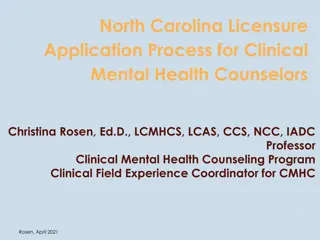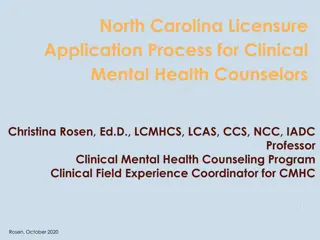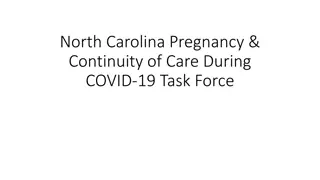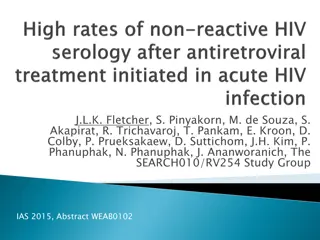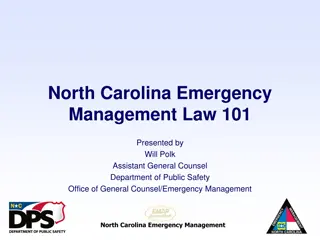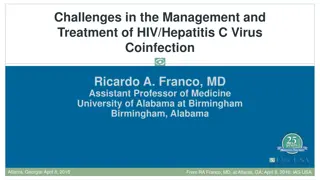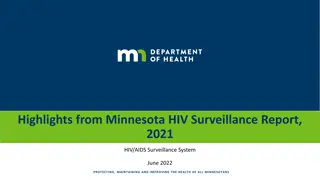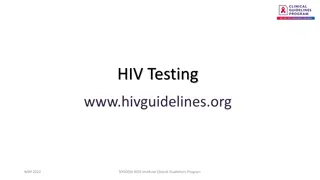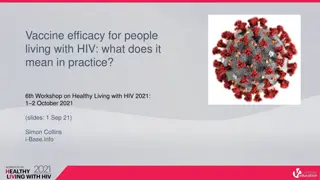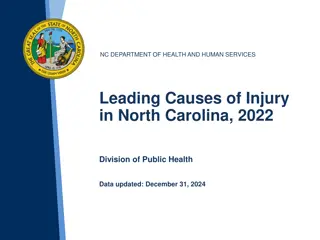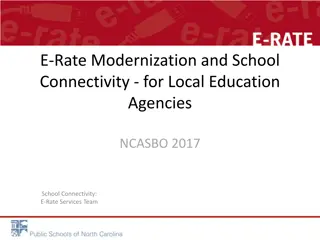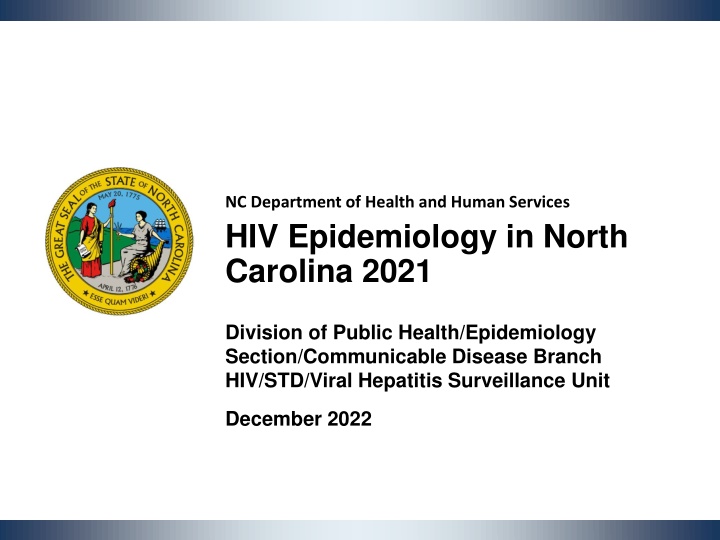
North Carolina HIV Epidemiology Insights 2021
Explore key insights from the 2021 HIV epidemiology data in North Carolina, including HIV rates by year of diagnosis, age distribution of people diagnosed with HIV, estimated HIV incidence from 2009 to 2021, and more. Dive into the demographic trends, new diagnoses, death rates, and prevalence statistics to understand the impact of HIV in North Carolina.
Download Presentation

Please find below an Image/Link to download the presentation.
The content on the website is provided AS IS for your information and personal use only. It may not be sold, licensed, or shared on other websites without obtaining consent from the author. If you encounter any issues during the download, it is possible that the publisher has removed the file from their server.
You are allowed to download the files provided on this website for personal or commercial use, subject to the condition that they are used lawfully. All files are the property of their respective owners.
The content on the website is provided AS IS for your information and personal use only. It may not be sold, licensed, or shared on other websites without obtaining consent from the author.
E N D
Presentation Transcript
NC Department of Health and Human Services HIV Epidemiology in North Carolina 2021 Division of Public Health/Epidemiology Section/Communicable Disease Branch HIV/STD/Viral Hepatitis Surveillance Unit December 2022 1 NC DHHS Division of Public Health | 2021 HIV Epidemiology in NC| December 2022
HIV in North Carolina 2 NC DHHS Division of Public Health | 2021 HIV Epidemiology in NC| December 2022
North Carolina HIV Rates by Year of Diagnosis, 2000-2021 Rate per 100,000 population Prevalence* New Diagnoses** Death Rate 400 30 Rate per 100,000 population 338 350 25 (Prevalence) (New Cases) 300 20 250 16 200 15 150 10 100 5 50 2 0 0 Year at Diagnosis ^Note: 2020 data should be treated with caution due to reduced availability of testing caused by the COVID-19 pandemic. *Based on most recent address in eHARS as of December 31 of the given year. **New cases are only among adults and adolescents (13 years and older). Data Source: enhanced HIV/AIDS Reporting System (eHARS) (data as of September 2022) and North Carolina Vital Statistics, Volume 2: Leading Causes of Death 2000-2019. 3 NC DHHS Division of Public Health | 2021 HIV Epidemiology in NC| December 2022
Age Distribution of People Diagnosed with HIV and Living in NC* by Gender** in 2021 Men Women Transgender 4,000 3,500 3,000 Number of Cases 2,500 2,000 1,500 1,000 500 0 Less than 13 13-14 15-19 20-24 25-29 30-34 35-39 40-44 45-49 50-54 55-59 60-64 65 and Older Current Age* *Based on most recent address or age in eHARS as of December 31 of the given year. **Transgender status is based on self-report; for exposure category, transgender people are classified by their recorded binary gender. Due to historical and current stigma, the total number of transgender people is likely to be an underestimation. This variable was not routinely captured until 2015 in our surveillance system. Data Source: enhanced HIV/AIDS Reporting System (eHARS) (data as of September 2022). 4 NC DHHS Division of Public Health | 2021 HIV Epidemiology in NC| December 2022
Estimated HIV Incidence in NC, 2009-2021^ HIV Incidence 95% CI (Lower Limit) 95% CI (Upper Limit) 2,000 1,800 1,600 1,400 1,200 Number 1,000 800 600 400 200 0 2008 2009 2010 2011 2012 2013 2014 2015 2016 2017 2018 2019 2020^ 2021 Year of Infection Estimated incidence using CDC s CD4 Model SAS code from August 2021. ^Note: 2020 data should be treated with caution due to reduced availability of testing caused by the COVID-19 pandemic. Data is italicized for this reason. Data Source: enhanced HIV/AIDS Reporting System (eHARS) (data as of September 2022). 5 NC DHHS Division of Public Health | 2021 HIV Epidemiology in NC| December 2022
Newly Diagnosed HIV among Adult and Adolescents (13 years and older) by Gender*, 2000-2021 Women Men Transgender 2,000 1,800 1,600 1,400 Number of Cases 1,400 36 1,200 1,000 1,123 800 600 400 200 241 0 Year at Diagnosis ^Note: 2020 data should be treated with caution due to reduced availability of testing caused by the COVID-19 pandemic. *Transgender status is based on self-report; for exposure category, transgender people are classified by their recorded binary gender. Due to historical and current stigma, the total number of transgender people is likely to be an underestimation. This variable was not routinely captured until 2015 in our surveillance system. Data Source: enhanced HIV/AIDS Reporting System (eHARS) (data as of September 2022) and North Carolina Engagement in Care Database for HIV Outreach (NC ECHO) (data as of September 2022). 6 NC DHHS Division of Public Health | 2021 HIV Epidemiology in NC| December 2022
Gender Distribution* of Newly Diagnosed HIV among Adult/Adolescent (13 years and older), 2021 Transgender* 3% Women 17% Men 80% *Transgender status is based on self-report; for exposure category, transgender people are classified by their recorded binary gender. Due to historical and current stigma, the total number of transgender people is likely to be an underestimation. This variable was not routinely captured until 2015 in our surveillance system. Data Source: enhanced HIV/AIDS Reporting System (eHARS) (data as of September 2022) and North Carolina Engagement in Care Database for HIV Outreach (NC ECHO) (data as of September 2022). 7 NC DHHS Division of Public Health | 2021 HIV Epidemiology in NC| December 2022
Gender Distribution* of Newly Diagnosed HIV among Adult/Adolescent (13 years and older), 2017-2021 Men Women Transgender* 1200 40 Number of Newly Diagnosed HIV Cases Number of Newly Diagnosed HIV Cases 35 1000 30 800 25 600 20 15 400 10 200 5 0 0 2017 2018 2019 2020^ 2021 Year of Diagnosis ^Note: 2020 data should be treated with caution due to reduced availability of testing caused by the COVID-19 pandemic. Data is italicized for this reason. *Transgender status is based on self-report; for exposure category, transgender people are classified by their recorded binary gender. Due to historical and current stigma, the total number of transgender people is likely to be an underestimation. This variable was not routinely captured until 2015 in our surveillance system. Data Source: enhanced HIV/AIDS Reporting System (eHARS) (data as September 2022) and North Carolina Engagement in Care Database for HIV Outreach (NC ECHO) (data as of September 2022). 8 NC DHHS Division of Public Health | 2021 HIV Epidemiology in NC| December 2022
Newly Diagnosed HIV Rates among Adult/Adolescent (13 years and older) by Gender, 2017-2021 Men Women 30.0 25.9 25.0 Rate per 100,000 population 20.0 15.0 10.0 5.2 5.0 0.0 2017 2018 2019 2020^ 2021 Year at Diagnosis ^Note: 2020 data should be treated with caution due to reduced availability of testing caused by the COVID-19 pandemic. Data Source: enhanced HIV/AIDS Reporting System (eHARS) (data as of September 2022) and North Carolina Engagement in Care Database for HIV Outreach (NC ECHO) (data as September 2022). 9 NC DHHS Division of Public Health | 2021 HIV Epidemiology in NC| December 2022
Age Distribution of Newly Diagnosed HIV among Adult/Adolescent (13 years and older) by Gender, 2007 Men Women 300 250 Number of Cases 200 150 100 50 0 13-14 15-19 20-24 25-29 30-34 35-39 40-44 45-49 50-54 55-59 60-64 65+ Age at Diagnosis Data Source: enhanced HIV/AIDS Reporting System (eHARS) (data as of September 2022). 10 NC DHHS Division of Public Health | 2021 HIV Epidemiology in NC| December 2022
Age Distribution of Newly Diagnosed HIV among Adult/Adolescent (13 years and older) by Gender, 2012 Men Women 300 250 Number of Cases 200 150 100 50 0 55-59 65+ 13-14 15-19 20-24 25-29 30-34 35-39 40-44 45-49 50-54 60-64 Age at Diagnosis Data Source: enhanced HIV/AIDS Reporting System (eHARS) (data as of September 2022). 11 NC DHHS Division of Public Health | 2021 HIV Epidemiology in NC| December 2022
Age Distribution of Newly Diagnosed HIV among Adult/Adolescent (13 years and older) by Gender*, 2021 Men Women Transgender* 300 12 250 10 Number of Cases Number of Cases 200 8 150 6 100 4 50 2 0 0 20-24 65+ 13-14 15-19 25-29 30-34 Age at Diagnosis (Year) 35-39 40-44 45-49 50-54 55-59 60-64 *Transgender status is based on self-report; for exposure category, transgender people are classified by their recorded binary gender. Due to historical and current stigma, the total number of transgender people is likely to be an underestimation. This variable was not routinely captured until 2015 in our surveillance system. Data Source: enhanced HIV/AIDS Reporting System (eHARS) (data as of September 2022) and North Carolina Engagement in Care Database for HIV Outreach (NC ECHO) (data as of September 2022). 12 NC DHHS Division of Public Health | 2021 HIV Epidemiology in NC| December 2022
Newly Diagnosed HIV Rates among Adult/Adolescent (13 years and older) by Age at Diagnosis, 2017-2021 13-14 age 40-44 age 15-19 age 45-49 age 20-24 age 50-54 age 25-29 age 55-59 age 30-34 age 60-64 age 35-39 age 65 and older 45.0 40.0 Rate per 100,000 population 35.0 30.0 25.0 20.0 15.0 10.0 5.0 0.0 2017 2018 2019 2020^ 2021 Year at Diagnosis ^Note: 2020 data should be treated with caution due to reduced availability of testing caused by the COVID-19 pandemic. Data Source: enhanced HIV/AIDS Reporting System (eHARS) (data as of September 2022) and North Carolina Engagement in Care Database for HIV Outreach (NC ECHO) (data as of Septmeber 2022). 13 NC DHHS Division of Public Health | 2021 HIV Epidemiology in NC| December 2022
Newly Diagnosed HIV Rates among Adult/Adolescent (13 years and older) Men by Age at Diagnosis, 2017-2021 13-14 age 40-44 age 15-19 age 45-49 age 20-24 age 50-54 age 25-29 age 55-59 age 30-34 age 60-64 age 35-39 age 65 and older 80.0 70.0 Rate per 100,000 population 60.0 50.0 40.0 30.0 20.0 10.0 0.0 2017 2018 2019 2020^ 2021 Year at Diagnosis ^Note: 2020 data should be treated with caution due to reduced availability of testing caused by the COVID-19 pandemic. Data Source: enhanced HIV/AIDS Reporting System (eHARS) (data as of September 2022) and North Carolina Engagement in Care Database for HIV Outreach (NC ECHO) (data as of September 2022). 14 NC DHHS Division of Public Health | 2021 HIV Epidemiology in NC| December 2022
Newly Diagnosed HIV Rates among Adult/Adolescent (13 years and older) Women by Age at Diagnosis, 2017-2021 13-14 age 40-44 age 15-19 age 45-49 age 20-24 age 50-54 age 25-29 age 55-59 age 30-34 age 60-64 age 35-39 age 65 and older 12.0 10.0 Rate per 100,000 population 8.0 6.0 4.0 2.0 0.0 2017 2018 2019 2020^ 2021 Year at Diagnosis ^Note: 2020 data should be treated with caution due to reduced availability of testing caused by the COVID-19 pandemic. Data Source: enhanced HIV/AIDS Reporting System (eHARS) (data as of September 2022). 15 NC DHHS Division of Public Health | 2021 HIV Epidemiology in NC| December 2022
Newly Diagnosed HIV Rates among Adult/Adolescent (13 years and older) by Race/Ethnicity, 2017-2021 American Indian/Alaskan Native** Hispanic/LatinX Asian/Pacific Islander** White/Caucasian** Black/African American** 50.0 43.5 45.0 Rate per 100,000 population 40.0 35.0 30.0 26.9 25.0 20.0 14.3 15.0 10.0 6.5 5.0 5.3 0.0 2017 2018 2019 2020^ 2021 Year at Diagnosis ^Note: 2020 data should be treated with caution due to reduced availability of testing caused by the COVID-19 pandemic. *Non-Hispanic/LatinX. Data Source: enhanced HIV/AIDS Reporting System (eHARS) (data as of September 2022). 16 NC DHHS Division of Public Health | 2021 HIV Epidemiology in NC| December 2022
Newly Diagnosed HIV Rates by County 2020^ ^Note: 2020 data should be treated with caution due to reduced availability of testing caused by the COVID-19 pandemic. Data Source: enhanced HIV/AIDS Reporting System (eHARS) (data as of September 2022). 17 NC DHHS Division of Public Health | 2021 HIV Epidemiology in NC| December 2022
Newly Diagnosed HIV Rates by County 2021^ Data Source: enhanced HIV/AIDS Reporting System (eHARS) (data as of September 2022). 18 NC DHHS Division of Public Health | 2021 HIV Epidemiology in NC| December 2022
HIV Exposure (Hierarchical Risk) 19 NC DHHS Division of Public Health | 2021 HIV Epidemiology in NC| December 2022
Newly Diagnosed HIV Hierarchical Risk^^ among Adults and Adolescents in NC 2017-2021 Heterosexual IDU^^ MSM^^ MSM/IDU^^ Other** Unknown^^^ 100% Percent of Newly Diagnosed HIV 90% 35.3% 80% 70% 3.0% 60% 50% 52.9% 40% 30% 20% 10% 2.7% 6.1% 0% 2017 2018 2019 2020^ 2021 Year of Diagnosis ^Note: 2020 data should be treated with caution due to reduced availability of testing caused by the COVID-19 pandemic. Data is italicized for this reason. ^^Risk was assigned to each case based on the reported risk that was most likely to have resulted in HIV transmission. While people may have reported more than one behavior that can transmit HIV, each person is only classified with one risk in this chart. *^^IDU = injection drug use; MSM = men who report sex with men; MSM/IDU = men who report sex with men and injection drug use. **Other risks include exposure to blood products (adult hemophilia or transfusions), pediatric risk, needle sticks, and health care exposure. ^^^Unknown risk is defined as individuals classified as no identified risk (NIR) and no reported risk (NRR) individuals. Data Source: enhanced HIV/AIDS Reporting System (eHARS) (data as of September 2022). 20 NC DHHS Division of Public Health | 2021 HIV Epidemiology in NC| December 2022
Newly Diagnosed HIV Hierarchical Risk^^ (Redistributed*) among Adults and Adolescents in NC, 2021 Heterosexual: 26% N = 1,400 MSM/IDU: 4% MSM: 66% IDU: 4% ^^Risk was assigned to each case based on the reported risk that was most likely to have resulted in HIV transmission. While people may have reported more than one behavior that can transmit HIV, each person is only classified with one risk in this chart. *Unknown risk has been redistributed. *Heterosexual-all is defined as a person who does not report IDU or MSM but does report sexual contact with a partner of opposite sex, who is IDU, MSM, or known HIV-positive status. Also, if a person is a victim of sexual assault, exchanges sex for drugs/money, has had a recent STD or has sexual contact while using drugs, they are classified as high risk. It also includes individuals classified as people who reports sex with an opposite sex partner and does not report IDU, MSM, or any other potential "high risk" behaviors. ^^IDU = injection drug use; MSM = men who report sex with men; MSM/IDU = men who report sex with men and injection drug use. **Other risks include exposure to blood products (adult hemophilia or transfusions), pediatric risk, needle sticks, and health care exposure. Data Source: enhanced HIV/AIDS Reporting System (eHARS) (data as of September 2022). 21 NC DHHS Division of Public Health | 2021 HIV Epidemiology in NC| December 2022
Proportion of Newly Diagnosed HIV Hierarchical Risk^^ (Redistributed*) among Adults and Adolescents in NC, 2017-2021 Heterosexual IDU MSM MSM/IDU Other 100% 90% 80% Percent of Newly Diagnosed HIV Cases 66% 70% 60% 50% 40% 26% 30% 20% 10% 4% 4% 0% 2017 2018 2019 2020^ 2021 Year at Diagnosis ^Note: 2020 data should be treated with caution due to reduced availability of testing caused by the COVID-19 pandemic. Data is italicized for this reason. ^^Risk was assigned to each case based on the reported risk that was most likely to have resulted in HIV transmission. While people may have reported more than one behavior that can transmit HIV, each person is only classified with one risk in this chart. *Unknown risk has been redistributed. *Heterosexual-all is defined as a person who does not report IDU or MSM, but does report sexual contact with a partner of opposite sex, who is IDU, MSM, or known HIV-positive status. Also, if a person is a victim of sexual assault, exchanges sex for drugs/money, has had a recent STD or has sexual contact while using drugs, they are classified as high risk. It also includes individuals classified as people who reports sex with an opposite sex partner and does not report IDU, MSM, or any other potential "high risk" behaviors. ^^IDU = injection drug use; MSM = men who report sex with men; MSM/IDU = men who report sex with men and injection drug use. **Other risks include exposure to blood products (adult hemophilia or transfusions), pediatric risk, needle sticks, and health care exposure. Data Source: enhanced HIV/AIDS Reporting System (eHARS) (data as of September 2022). 22 NC DHHS Division of Public Health | 2021 HIV Epidemiology in NC| December 2022
Estimated HIV Infection Rates among Newly Diagnosed Adult and Adolescents (13 years and older) Gay and Bisexual Men and Other Men who have Sex with Other Men^ in North Carolina 2021 North Carolina 2021 HIV Rate: 15.7 per 100,000 Total Gay and Bisexual Men and Other Men who have Sex with Men^^ 733 13 to 30 years old 1,467 Age Over 30 years old 355 American Indian/Alaska Native* 718 Asian/Pacific Islander* 386 Race/Ethnicity 2,169 Black/African American* Hispanic/LatinX 1,314 White/Caucasian* 215 Rate per 100,000 estimated gay and bisexual men population ^Unknown risk has been redistributed. People who were classified as MSM and IDU were excluded. ^^Grey et al (2016). JMIR Public Health Surveill; 2(1): e14. https://publichealth.jmir.org/2016/1/e14/ *Non-Hispanic/LatinX. Data Source: enhanced HIV/AIDS Reporting System (eHARS) (data as of September 2022). 23 NC DHHS Division of Public Health | 2021 HIV Epidemiology in NC| December 2022
Estimated HIV Infection Rates among Newly Diagnosed Adult and Adolescents (13 years and older) Heterosexual Men^ in North Carolina 2021 North Carolina 2021 HIV Rate: 15.7 per 100,000 Total Heterosexual Men 3.0 13 to 30 years old 3.0 Age Over 30 years old 3.0 American Indian/Alaska Native* 7.0 Race/Ethnicity Asian/Pacific Islander* 1.0 Black/African American* 10.0 Hispanic/Latino 6.0 White/Caucasian* 1.0 0 1 2 3 4 5 6 7 8 9 10 11 Rate per 100,000 estimated heterosexual men in NC ^Unknown risk has been redistributed. People who were classified as MSM and IDU were excluded. ^^Grey et al (2016). JMIR Public Health Surveill; 2(1): e14. https://publichealth.jmir.org/2016/1/e14/ *Non-Hispanic/LatinX. Data Source: enhanced HIV/AIDS Reporting System (eHARS) (data as of September 2022). 24 NC DHHS Division of Public Health | 2021 HIV Epidemiology in NC| December 2022
HIV Infection Rates among Newly Diagnosed Adult and Adolescents (13 years and older) Heterosexual Women^ in North Carolina 2021 North Carolina 2021 HIV Rate: 15.7 per 100,000 Total Women^^ 5 13-30 years old 5 Age Over 30 years old 5 American Indian/Alaska Native* 0 Asian/Pacific Islander* Race/Ethnicity 1 Black/African American* 16 Hispanic/Latino 3 White/Caucasian* 1 0 5 10 15 20 Rate per 100,000 women in NC ^Unknown risk has been redistributed. People who were classified as MSM and IDU were excluded. ^^Grey et al (2016). JMIR Public Health Surveill; 2(1): e14. https://publichealth.jmir.org/2016/1/e14/ *Non-Hispanic/LatinX. Data Source: enhanced HIV/AIDS Reporting System (eHARS) (data as of September 2022). 25 NC DHHS Division of Public Health | 2021 HIV Epidemiology in NC| December 2022
Late Diagnosis of HIV (HIV and AIDS within 6 months) 26 NC DHHS Division of Public Health | 2021 HIV Epidemiology in NC| December 2022
Rate of Late Diagnoses of HIV by Gender, 2010-2021 Men Women Overall Rate of Late Diagnosis of HIV per 100,000 10 8.9 9 7.9 7.6 8 7.3 7 6.3 5.9 5.7 5.7 5.6 6 4.9 5.0 4.8 4.6 4.4 5 4.3 4.1 3.9 3.7 3.6 3.4 4 3.2 2.6 2.6 2.6 2.5 2.4 3 2.2 1.9 1.8 1.6 1.5 1.5 1.4 2 1.0 1.0 0.9 1 0 Year of HIV Diagnosis ^Note: 2020 data should be treated with caution due to reduced availability of testing caused by the COVID-19 pandemic. Data Source: enhanced HIV/AIDS Reporting System (eHARS) (data as of September 2022). 27 NC DHHS Division of Public Health | 2021 HIV Epidemiology in NC| December 2022
Proportion of Late Diagnosed HIV by Gender and Race/Ethnicity, 2021 Women=120 Men=384 2%1% 3% 7% American Indian/Alaska Native^ 5% Asian/Pacific Islander^ 27% 17% Black/African American^ Hispanic/LatinX 7% White/Caucasian^ 15% Multiple Race 55% 68% ^Non-Hispanic/LatinX. Data Source: enhanced HIV/AIDS Reporting System (eHARS) (data as of September 2022). 28 NC DHHS Division of Public Health | 2021 HIV Epidemiology in NC| December 2022
HIV Comorbidities 29 NC DHHS Division of Public Health | 2021 HIV Epidemiology in NC| December 2022
Syphilis Coinfection with HIV 30 NC DHHS Division of Public Health | 2021 HIV Epidemiology in NC| December 2022
People with Early Syphilis* Coinfected with HIV** by Gender, 2000-2021 Men Women 100% Percent of Syphilis Cases Co- 80% Infected with HIV 60% 44.9% 40% 20% 2.7% 0% Year at Diagnosis *Early syphilis is defined as having primary, secondary, or early non-primary non-secondary (formerly early latent) syphilis. **HIV diagnosed prior to OR within 30 days of syphilis diagnosis. ^^2020 data should be treated with caution due to reduced availability of testing caused by the COVID-19 pandemic. Data Source: North Carolina Electronic Disease Surveillance System (NC EDSS) (data as of September, 2022) and enhanced HIV/AIDS Reporting System (NC EDSS) (data as of September 2022). 31 NC DHHS Division of Public Health | 2021 HIV Epidemiology in NC| December 2022
People with Early Syphilis* Coinfected with HIV** by Race/Ethnicity, 2017-2021 American Indian/Alaskan Native** Hispanic/LatinX Unknown/Unspecified Asian/Pacific Islander** White/Caucasian** Black/African American** Mulitple Races Percent of Syphilis Cases Co- 100% 4.2% 90% Infected with HIV 16.6% 80% 9.0% 70% 60% 50% 40% 68.9% 30% 20% 10% 1.0% 0% 2017 2018 2019 2020^^ 2021 Year at Diagnosis *Early syphilis is defined as having primary, secondary, or early non-primary non-secondary (formerly early latent) syphilis. **HIV diagnosed prior to OR within 30 days of syphilis diagnosis. ^^2020 data should be treated with caution due to reduced availability of testing caused by the COVID-19 pandemic. Data Source: North Carolina Electronic Disease Surveillance System (NC EDSS) (data as of September, 2022) and enhanced HIV/AIDS Reporting System (NC EDSS) (data as of September, 2022). 32 NC DHHS Division of Public Health | 2021 HIV Epidemiology in NC| December 2022
Gonorrhea Coinfection with HIV 33 NC DHHS Division of Public Health | 2021 HIV Epidemiology in NC| December 2022
People with Gonorrhea Coinfected with HIV^^ by Gender, 2010-2021 Men Women 12% Percent of Gonorrhea Cases Co- 10.06% 10% Infected with HIV 8% 6% 4% 2% 0.63% 0% Year at Diagnosis ^^HIV diagnosed prior to OR within 30 days of gonorrhea diagnosis. *2020 data should be treated with caution due to reduced availability of testing caused by the COVID-19 pandemic. Data Source: North Carolina Electronic Disease Surveillance System (NC EDSS) (data as of September 2022) and enhanced HIV/AIDS Reporting System (NC EDSS) (data as of September 2022). 34 NC DHHS Division of Public Health | 2021 HIV Epidemiology in NC| December 2022
People with Gonorrhea Coinfected with HIV^^ by Race/Ethnicity, 2017-2021 American Indian/Alaskan Native** Hispanic/LatinX Unknown/Unspecified Asian/Pacific Islander** White/Caucasian** Black/African American** Mulitple Races Proportion of Gonorrhea Cases Co- 100% 6.0% 1.8% 90% 13.5% Infected with HIV 80% 8.5% 70% 60% 50% 68.4% 40% 30% 20% 10% 0.8% 1.0% 0% 2017 2018 2019 2020* 2021 Year at Diagnosis ^^HIV diagnosed prior to OR within 30 days of gonorrhea diagnosis. *2020 data should be treated with caution due to reduced availability of testing caused by the COVID-19 pandemic. Data is italicized for this reason. Data Source: North Carolina Electronic Disease Surveillance System (NC EDSS) (data as of September 2022) and enhanced HIV/AIDS Reporting System (NC EDSS) (data as of September 2022). 35 NC DHHS Division of Public Health | 2021 HIV Epidemiology in NC| December 2022
Hepatitis Coinfection with HIV 36 NC DHHS Division of Public Health | 2021 HIV Epidemiology in NC| December 2022
Conquering the Syndemic: The Impact of HCV, HIV, and Opioid Overdoses in North Carolina HCV Reported acute HCV, 20211 = 100 Estimated people living with chronic HCV in U.S., 20162 = 2.4 million (Trends in mortality and curative treatment indicate the prevalence is lower today.) Average lifetime treatment cost of chronic HCV3 = $100,000/person Syndemic Estimate 7-13% of HIV-infected people in NC are co-infected with HCV (CDC estimates 21%)4,5 At least 7% of people diagnosed with HIV in NC in 2021 were exposed through injection drug use1 An estimated 62% 80% of HIV-infected people who inject drugs are co-infected with HCV5 Around 53% of people with acute HCV in 2021 reported injection drug use1 Based on surveillance data, 17% of people coinfected with HIV/HCV achieved SVR through 20211 Opioid Overdoses HIV Infections Drug overdose deaths in NC, 20206 = 3,801 (36.2 per 100,000) Heroin deaths, 20186 = 619 (6.3 per 100,000) CDC estimates the cost of drug overdose deaths in NC, 20167 = $1.3 billion Newly reported HIV, 20211 = 1,400 People living with HIV, 20211 = 35,632 Average lifetime treatment cost of HIV8 = >$370,000/person 1NC HIV/STD/Hepatitis Annual Surveillance Report, 2021; 2CDC Surveillance for Viral Hepatitis (https://www.cdc.gov/hepatitis/hcv/hcvfaq.htm#Ref01). 3In the absence of liver transplant (C. Everett Koop Institute, Dartmouth http://www.epidemic.org/thefacts/theepidemic/USHealthCareCosts/ );4Based on estimates from NC Ryan White CAREWare and the Medical Monitoring Project in NC;5People Coinfected with HIV and Viral Hepatitis https://www.cdc.gov/hepatitis/populations/hiv.htm; 6 Opioid and Substance Use Action Plan Data Dashboard https://www.ncdhhs.gov/about/department-initiatives/opioid-epidemic/opioid- action-plan-data-dashboard; 7https://www.drugabuse.gov/drug-topics/opioids/opioid-summaries-by-state/north-carolina-opioid-involved-deaths-related-harms. 8HIV Cost-effectiveness, CDC: https://www.cdc.gov/hiv/programresources/guidance/costeffectiveness/index.html). 37 NC DHHS Division of Public Health | 2021 HIV Epidemiology in NC| December 2022
2021 HIV/Hepatitis B/Hepatitis C Coinfection HCV N = 78,121 N=1,277 N=1,254 N=55 HBV HIV N=24,850 N=33,193 N=1,130 . Data Source: North Carolina Electronic Disease Surveillance System (NC EDSS) (data as of October 1, 2022) and enhanced HIV/AIDS Reporting System (NC EDSS) (data as of October 1, 2022). 38 NC DHHS Division of Public Health | 2021 HIV Epidemiology in NC| December 2022
North Carolina HIV Continuum of Care 39 NC DHHS Division of Public Health | 2021 HIV Epidemiology in NC| December 2022
North Carolina HIV Continuum of Care 2021* Percent of People Living with HIV in 100% 89% 90% 78% 80% 72% 67% 70% 60% NC 50% 40% 30% 20% 10% 0% Diagnosed & Reported At Least 1 Care Visit ** Retained in Care*** Virally Suppressed *Note: Data are preliminary (do not include vital records or national death matches). **At least 1 care marker (CD4 or VL test, HMAP dispense, or Medicaid claim) in the given calendar year. ***Retained in care is defined as being virally suppressed within 12 months or having 2 or more care markers (CD4 or VL test, HMAP dispense, or Medicaid claim) at least 90 days apart in the given calendar year. ^Virally suppressed is defined as the last viral load during the given calendar year <200 copies/ml. Legend: People 13 years of age and diagnosed and living through December 31 of each calendar year. Data includes labs and services from CAREWare (all Ryan White services excluding Part A), HIV Medication Assistance Program (HMAP), and Medicaid data sources. The estimated number of people living in North Carolina in 2020 was 38,900 (based on CD4 model from CDC July 2021). Data Sources: enhanced HIV/AIDS Reporting System (eHARS) (June 2022) and NC ECHO (July 2022). 40 NC DHHS Division of Public Health | 2021 HIV Epidemiology in NC| December 2022
Upside Down HIV Continuum of Care 2021* Undiagnosed* No Care Visit ** Not Retained in Care*** Not Virally Suppressed^ 0% Percent of People Living with HIV in NC 10% 11% 20% 22% 30% 28% 33% 40% 50% 60% 70% 80% 90% 100% *Note: Data are preliminary (do not include vital records or national death matches). **No care visit (CD4 or VL test, HMAP dispense, or Medicaid claim) in the given calendar year. ***Not retained in care is defined as being virally suppressed within 12 months or having 2 or more care markers (CD4 or VL test, HMAP dispense, or Medicaid claim) at least 90 days apart in the given calendar year. ^Not virally suppressed is defined as the last viral load during the given calendar year <200 copies/ml. Legend: People 13 years of age and living through December 31 of each calendar year. Data includes labs and services from CAREWare (all Ryan White services excluding Part A), HIV Medication Assistance Program (HMAP), and Medicaid data sources. The estimated number of people living in North Carolina in 2020 was 38,900 (based on CD4 model from CDC July 2021). Data Sources: enhanced HIV/AIDS Reporting System (eHARS) (June 2022) and NC ECHO (July 2022). 41 NC DHHS Division of Public Health | 2021 HIV Epidemiology in NC| December 2022
HIV Continuum of Care: North Carolina and the United States^, 2021* North Carolina United States Percent of People Living with HIV 100% 89% 86% 90% 78% 80% 72% 67% 65% 70% in NC 56% 60% 50% 50% 40% 30% 20% 10% 0% Diagnosed & Reported At Least 1 Care Visit ** Retained in Care*** Virally Suppressed Note: Data are preliminary (do not include vital records or national death matches). ^Most recent CDC continuum is data from 2016 of jurisdictions with complete lab reporting (https://www.cdc.gov/hiv/pdf/library/factsheets/cdc-hiv-national-hiv-care-outcomes.pdf). **At least 1 care marker (CD4 or VL test, HMAP dispense, or Medicaid claim) in the given calendar year. ***Retained in care is defined as being virally suppressed within 12 months or having 2 or more care markers (CD4 or VL test, HMAP dispense, or Medicaid claim) at least 90 days apart in the given calendar year. ^Virally suppressed is defined as the last viral load during the given calendar year <200 copies/ml. Legend: People 13 years of age and diagnosed and living through December 31 of each calendar year. Data includes labs and services from CAREWare (all Ryan White services excluding Part A), HIV Medication Assistance Program (HMAP), and Medicaid data sources. The estimated number of people living in North Carolina in 2020 was 38,900 (based on CD4 model from CDC July 2021). Data Sources: enhanced HIV/AIDS Reporting System (eHARS) (June, 2022) and NC ECHO (July 2022). 42 NC DHHS Division of Public Health | 2021 HIV Epidemiology in NC| December 2022
2021* North Carolina Newly Diagnosed HIV Continuum of Care 1,400 92% 89% 1,200 Number of Newly Diagnosed HIV 74% 71% 1,000 800 600 400 200 0 Diagnosed & Reported Linked to Care within 1 Linked to Care within 3 Months Linked to Care within 6 Months Virally Suppressed ^^ Month ^^Virally suppressed is defined as the last viral load during the given calendar year being <200 copies/ml. Legend: Newly diagnosed people with HIV in 2020. Data includes labs and services from CAREWare (all Ryan White services excluding Part A), HIV Medication Assistance Program (HMAP), and Medicaid data sources. Data Sources: enhanced HIV/AIDS Reporting System (eHARS) (June, 2022) and NC ECHO (July 2022). 43 NC DHHS Division of Public Health | 2021 HIV Epidemiology in NC| December 2022
90-90-90 Status in 2021: North Carolina 100% 90% 89% 86% 80% 70% 71% 60% 50% 40% 30% 20% 10% 0% 90% of all people living with HIV will know their HIV status. 90% of all people diagnosed will receive sustained antiretroviral therapy (ARTs). 90% of all people with diagnosed HIV infection and on ART will have viral suppression. *People 13 years of age and diagnosed in and living through December 31 of each calendar year. Data includes labs and services from CAREWare (all Ryan White services excluding Part A), HIV Medication Assistance Program (HMAP), and Medicaid data sources. Data are preliminary (do not include vital records or national death matches). *received ARTs is based on the number of people with a viral load in a given year (assumes viral load test implies receipt of ARTs) ^Among persons with at least one care visit in 2021. Virally suppressed is defined as having last viral load test during the given calendar year <200 copies/ml. Data Sources: enhanced HIV/AIDS Reporting System (eHARS) (June 2022) and NC ECHO (July 2022). NOTE: The proportion of people virally suppressed among those in care was originally miscalculated and has been corrected. 44 NC DHHS Division of Public Health | 2021 HIV Epidemiology in NC| December 2022


